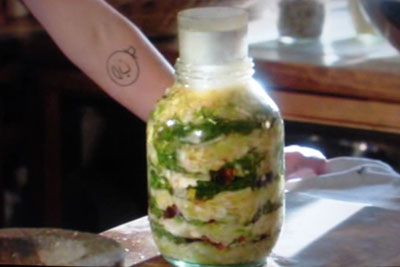 Steve's Home Brewed Sauerkraut
Steve's Home Brewed Sauerkraut
From: oran@nutcom.com (SRitter)
Those who never liked Sauerkraut, had never eaten home made sauerkraut. This is nothing at all like the store bought one. No way no how. Guaranteed, or your money back!!! :)
Take a large head of cabbage and clean outer leaves until you see no damage on them at all. Slice the cabbage thin. Save one large leaf. You may certainly make more if you wish. But there is nothing wrong with making just a head. The recipe works the same. (Use a clay pot if possible, but I have been making this in all kinds of jars. Glass or even hard plastic. Just clean it well with HOT water.))
Put the cabbage in the pot, press it down, and cover it 3/4 ways with lukewarm water that has been salted. 1 Tablespoon of salt dissolved in 1 quart water is the right amount. Cover it all with the leaf you saved and top it with a small slice of Sourdough bread. This will start the fermentation. Cover it all with a plate upside down, that does not completely cover the cabbage. It has to be smaller than the pot. Place it on the cabbage upside down, then put a weight on it. I used bricks, canned foods, whatever. It should be enough weight to press the cabbage under the water. You may place the weight into plastic wrap, so it won't get in contact and make the cabbage dirty. Keep the pot in a warm place. Summertime this is easy. When it's colder, you can put it into places like the top of the refrigerator where the hot air flows.
In 3 to 5 days, you will have the crunchiest, best tasting sauerkraut you have ever had! I've been making sauerkraut like this for decades. My problem is, that I make it to use in stuffed cabbage, and other cabbage dishes, however, when I taste it, and start eating it, I just can't stop:) Normally I eat at least half of it before I get to use it.
Sauerkraut
From Sandor Ellix Katz, Wild Fermentation: The Flavor, Nutrition, and Craft of Live-Culture Foods (Chelsea Green, 2003) http://www.wildfermentation.com/ (plus my extra notes).
Timeframe: 1-4 weeks (or more)
Special Equipment:
Ceramic or glass crock or food-grade plastic bucket, one-gallon capacity or greater
Plate that fits inside crock or bucket
One-gallon jug filled with water (or a scrubbed and boiled rock)
Cloth cover (like a pillowcase or towel)
Ingredients (for 1 gallon):
5 pounds cabbage
3 tablespoons sea salt
Chop or grate cabbage, finely or coarsely, with or without hearts, however you like it. I love to mix green and red cabbage to end up with bright pink kraut. Place cabbage in a large bowl as you chop it (smaller is better as the juices will flow out better).
Sprinkle salt on the cabbage as you go. The salt pulls water out of the cabbage (through osmosis), and this creates the brine in which the cabbage can ferment and sour without rotting. The salt also has the effect of keeping the cabbage crunchy, by inhibiting organisms and enzymes that soften it. 3 tablespoons of salt is a rough guideline for 5 pounds of cabbage. I never measure the salt; I just shake some on after I chop up each cabbage. I use more salt in summer, less in winter.
Add other vegetables. Grate carrots for a coleslaw-like kraut. Other vegetables I’ve added include onions, garlic, seaweed, greens, Brussels sprouts, small whole heads of cabbage, turnips, beets, and burdock roots. You can also add fruits (apples, whole or sliced, are classic), and herbs and spices (caraway seeds, dill seeds, celery seeds, and juniper berries are classic, but anything you like will work). Experiment.
Mix ingredients together and pack into crock. Pack just a bit into the crock at a time and tamp it down hard using your fists or any (other) sturdy kitchen implement. The tamping packs the kraut tight in the crock and helps force water out of the cabbage (extra note, this also breaks down the cabbage structure and helps release the juices, the cabbage can be pouded before packing).
Cover kraut with a plate or some other lid that fits snugly inside the crock. Place a clean weight (a glass jug filled with water) on the cover. This weight is to force water out of the cabbage and then keep the cabbage submerged under the brine (& keep and bacteria out). Cover the whole thing with a cloth to keep dust and flies out.
Press down on the weight to add pressure to the cabbage and help force water out of it. Continue doing this periodically (as often as you think of it, every few hours), until the brine rises above the cover. This can take up to about 24 hours, as the salt draws water out of the cabbage slowly. Some cabbage, particularly if it is old, simply contains less water. If the brine does not rise above the plate level by the next day, add enough salt water to bring the brine level above the plate. Add about a teaspoon of salt to a cup of water and stir until it’s completely dissolved.
Leave the crock to ferment. I generally store the crock in an unobtrusive corner of the kitchen where I won’t forget about it, but where it won’t be in anybody’s way. You could also store it in a cool basement if you want a slower fermentation that will preserve for longer.
Check the kraut every day or two. The volume reduces as the fermentation proceeds. Sometimes mold appears on the surface. Many books refer to this mold as “scum,” but I prefer to think of it as a bloom. Skim what you can off of the surface; it will break up and you will probably not be able to remove all of it. Don’t worry about this. It’s just a surface phenomenon, a result of contact with the air. The kraut itself is under the anaerobic protection of the brine. Rinse off the plate and the weight. Taste the kraut. Generally it starts to be tangy after a few days, and the taste gets stronger as time passes. In the cool temperatures of a cellar in winter, kraut can keep improving for months and months. In the summer or in a heated room, its life cycle is more rapid.
Eventually it becomes soft and the flavor turns less pleasant.
Enjoy. I generally scoop out a bowl- or jarful at a time and keep it in the fridge. I start when the kraut is young and enjoy its evolving flavor over the course of a few weeks. Try the sauerkraut juice that will be left in the bowl after the kraut is eaten. Sauerkraut juice is a rare delicacy and unparalleled digestive tonic. Each time you scoop some kraut out of the crock, you have to repack it carefully. Make sure the kraut is packed tight in the crock, the surface is level, and the cover and weight are clean. Sometimes brine evaporates, so if the kraut is not submerged below brine just add salted water as necessary. Some people preserve kraut by canning and heat-processing it. This can be done; but so much of the power of sauerkraut is its aliveness that I wonder: Why kill it?
Develop a rhythm. I try to start a new batch before the previous batch runs out. I remove the remaining kraut from the crock, repack it with fresh salted cabbage, then pour the old kraut and its juices over the new kraut. This gives the new batch a boost with an active culture starter

From Alys Fowlers Edible Garden (BBC) using a Soil Sisters (Miche Fabre Lewin & Daphne Lambert) recipe, here it is layered with Swiss Chard

